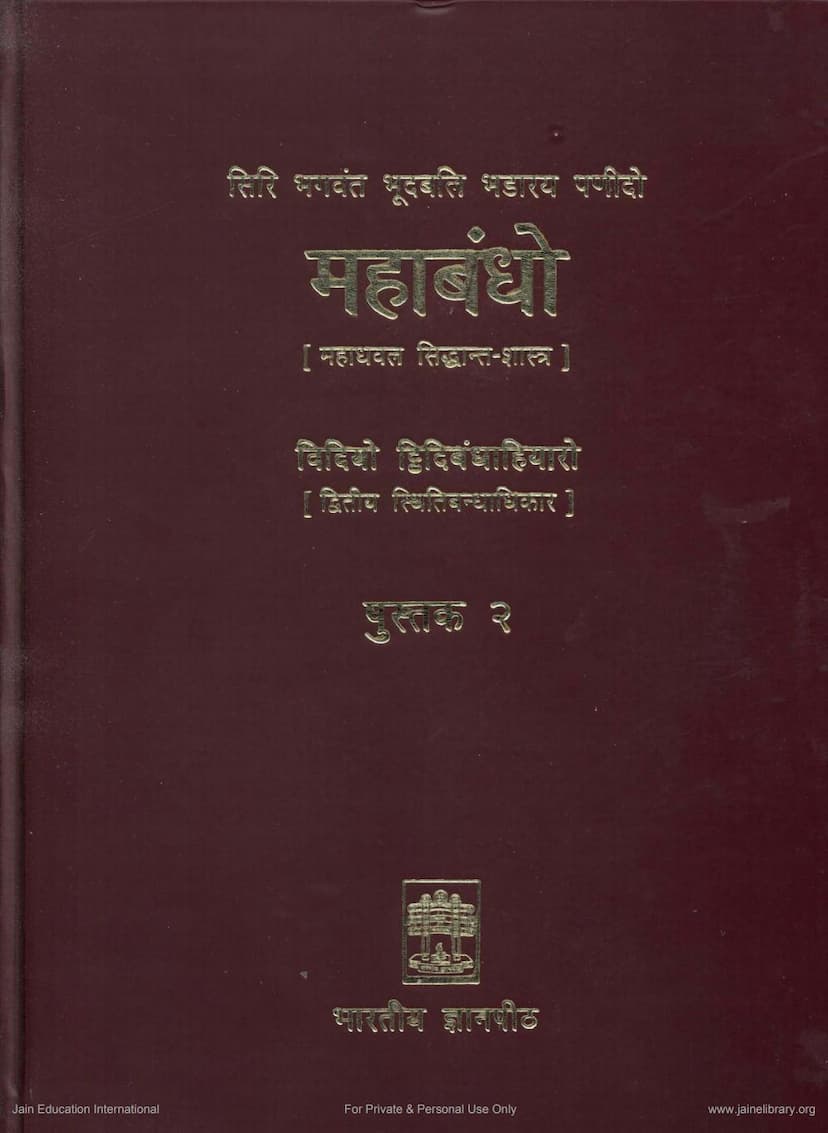Mahabandho Part 2
Added to library: September 2, 2025

Summary
This is a summary of the provided Jain text, specifically focusing on the content related to Mahabandho Part 2 (Sthiti-bandhādhikāra) by Bhagvan Bhutabali, edited and translated by Pt. Phoolchandra Siddhantashastri, and published by Bharatiya Jnanpith.
The provided text appears to be primarily the table of contents and introductory sections of the book, rather than the full content of the "Sthiti-bandhādhikāra" itself. However, based on the available pages, we can glean the following:
Book Information:
- Title: Mahabandho Part 2 (Second Part: Sthiti-bandhādhikāra)
- Author: Bhagvan Bhutabali
- Editor and Translator: Pt. Phoolchandra Siddhantashastri
- Publisher: Bharatiya Jnanpith
- Series: Moortidevi Jain Granthamala: Prakrita Grantha No. 4
- Edition: Second Edition, 1998
Key Content Areas (as indicated by the table of contents and introductory sections):
The book "Mahabandho" is presented as a commentary or explanation of the "Shatkhandagama." It is divided into four main sections (Anuyogadwaras):
- Prakriti-bandha (Nature of Karma Binding): This part seems to have been published earlier.
- Sthiti-bandha (Duration of Karma Binding): This is the subject of the current volume (Part 2). It is further divided into two main areas:
- Mula-prakriti-sthiti-bandha (Duration of Binding of Primary Karmas): This section appears to be the primary focus of the book. It is further broken down into four sub-sections (Anuyogadwaras):
- Sthiti-bandha-sthana-praroopana (Analysis of States of Karma Duration Binding): Discusses the different states or levels of karma duration binding.
- Nishek-praroopana (Analysis of Layers of Karma Binding): Examines how karmic particles are deposited over time.
- Ābādhā-kāṇḍaka-praroopana (Analysis of the Period of Obstruction of Karma): Deals with the initial period during which the effects of karma are obstructed.
- Alpa-bahu-tva (Minority and Majority): Compares the quantities of different karmic elements.
- Uttara-prakriti-sthiti-bandha (Duration of Binding of Secondary Karmas): This section also follows a similar structure with four Anuyogadwaras.
- Mula-prakriti-sthiti-bandha (Duration of Binding of Primary Karmas): This section appears to be the primary focus of the book. It is further broken down into four sub-sections (Anuyogadwaras):
- Anubhaga-bandha (Intensity of Karma Binding): This section, though mentioned as one of the four main parts, is not detailed in the provided pages.
- Pradesha-bandha (Quantity of Karma Binding): This section, also mentioned as one of the four main parts, is not detailed in the provided pages.
Introductory and Contextual Information:
- Historical Context: The introduction and preface highlight the importance of the "Mahabandho" as a crucial text for understanding Jain philosophy, particularly the "Shatkhandagama." It mentions the lineage of Acharyas like Dharasena, Pushpadanta, and Bhutabali who preserved and expounded these teachings.
- Moortidevi Jain Granthamala: Bharatiya Jnanpith's commitment to publishing ancient Jain literature in various languages, including critical editions and translations, is emphasized.
- Editorial Process: The preface by Pt. Phoolchandra Siddhantashastri details the challenges faced during the editing process, including the scarcity of manuscripts and the meticulous work involved in collation and translation. It also acknowledges the support of the Bharatiya Jnanpith.
- Content of Sthiti-Bandhādhikāra: The second part focuses on the duration (sthiti) of karma binding. It explores how the duration of different karmas (mula-prakriti) and their sub-categories (uttara-prakriti) is determined for a single soul (jiva) based on various factors like life-forms (ekendriya, dwi-indriya, etc.), states of consciousness (samjñi/asanjñi), and spiritual development (gunasthanas). The text delves into concepts like the number of possible duration states, the period of obstruction (ābādhā), and the relative quantities of karmic matter.
- Specific Concepts Discussed:
- Karma Theory: The text begins by establishing the foundation of the karma theory, explaining how the soul binds karma due to passions (raga, dwesha, moha) and is liberated through right faith, knowledge, and conduct.
- Life-forms (Jiva Samāsa): It categorizes souls into different life-forms (e.g., by senses, states of existence like aparyāpta/paryāpta) and analyzes the karma duration binding in each.
- Duration Binding (Sthiti-bandha): This is the core concept, detailing how the duration of various karmas is calculated, influenced by factors like passions (kashāya) and the soul's state.
- Ābādhā: The period during which the karmic effect is not experienced is discussed in detail, including its calculation for different karmas and life-forms.
- Alpa-bahu-tva: Comparisons of quantities are made to understand the relative magnitude of different karmic elements.
- Detailed Analysis: The table of contents indicates a comprehensive analysis of numerous sub-topics within Sthiti-bandha, covering concepts like Anantaropanishada and Paramparopanishada for Nishek, and various subdivisions for Sthiti-bandha states, ābādhā, and quantities.
Overall Significance:
The "Mahabandho Part 2" is presented as a profound and detailed exposition of the Jain theory of karma, specifically the duration aspect. It continues the detailed philosophical and analytical tradition of Jainism, providing intricate explanations for complex concepts related to karmic bondage. The text is aimed at scholars and serious students of Jain philosophy seeking a deep understanding of these principles.